The ‘C-class’ Spanish cruisers: Blas de Lezo class
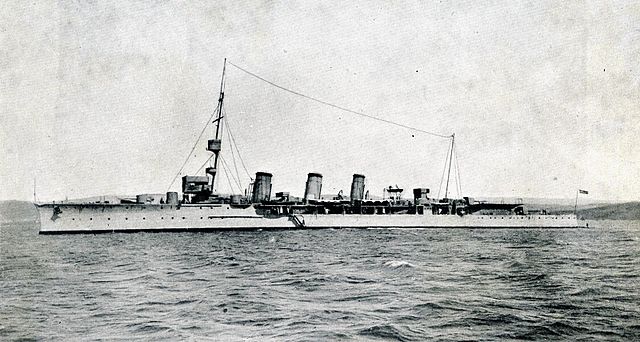
Blas de Lezo in 1929
The Méndez Núñez and Blas de Lezo were a second class of british ‘C-class’ cruisers, made with British-supplied equipments in Spain, at Ferrol. The first world war unfortunately domed these cruisers ordered just when the war broke out and none were completed in time, but well after the war in 1923, 1924 and 1925. As a result they were already obsolescent in 1930 when the old regime fell and Spain was found itself as a Republic.
However in 1932, Blas de Lezo was wrecked, while in 1936 Reina Victoria Eugenia was taken in hands to be rebuilt, leaving only the Méndez Núñez to participate actively in naval operations during the civil war. She will know a new carrier as an AA cruiser during the cold war, totally rebuilt.
Spanish Cruisers in 1914
When WW1 broke out, the Spanish Armada had to rebuilt itself after the losses of the 1898 war with the United States. After the surviving 9000 tons Emperador Carlos V, the two surviving 7500 tons Cataluna class armoured cruisers (Cardenal Cisneros was wrecked in 1905), the small French-built colonial cruiser Rio de la Plata (1870 tons). New ships included the modest protected cruiser Estramadura (2030 tons) but also the modern (1906) Reina Regente.
The latter looked looked fine with her three funnels, flush deck hull, and was armed with ten shielded 6-in guns (by 3 in armor), 12 6-pdr QF guns and two 1-pdr and three torpedo tubes. She was protected by and armoured deck of about 3 1/2 inches (about 85 mm), like the walls of the conning tower.
She was given standard triple expansion steam engines and like previous cruisers can reach 20 knots. However she has been originally proposed in 1896 but was not completed before 1908. At that time, the park of Spanish cruisers was already obsolescent. Budgetary constraints however delayed a substantial naval plan. Eventually it came before the war, with orders for dreadnoughts and modern cruisers, all to be built on British plans.
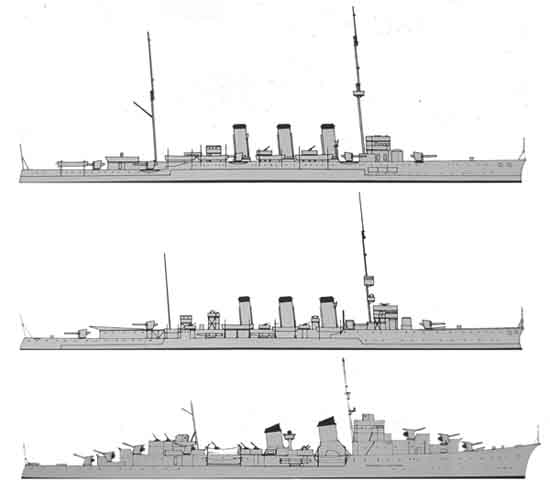
Comparison between the Reina Eugenia Victoria (top), Blas de Lezo (middle) and Méndez Núñez after 1947.
Construction of the new cruisers 1915-17
The first step was the navy law of 30 July 1914 to order the first ship to Ferrol, on British Vickers Armstrong plans. This was to be the Reina Victoria Eugenia. Unfortunately, and despite being neutral, Spain could not proceed with this clone of the HMS Birmingham without parts, equipment and artillery for the UK, now fully engaged on the western front and mobilized against Germany.
Laid down in March 1915, she was not launched before 1920 and completed in 1923. She will be known as a brand new ship at the end of the civil war on the Nationalist side, as Navarra.
These ships were authorized by means of the modification of the Miranda law, replaced by the so-called Cortina after the Minister of the Navy, Marquis de Cortina. On paper were defined two fast cruisers able to perform scouting missions for the new dreadnoughts. The navy law of February 1915 authorized cruisers close to the early and prolific contemporary British C-class cruisers, part of the enlarged “Town” superclass of light cruisers, the spearheads of the Royal Navy during the war. This was to be the second class.
Both were also to be laid down at Ferrol DyD, and two more ships were planned to be order in 1919, but were cancelled. They suffered the same issues as the Méndez Núñez and Blas de Lezo: Lack of spare parts and materials, no boilers nor armament from the UK.
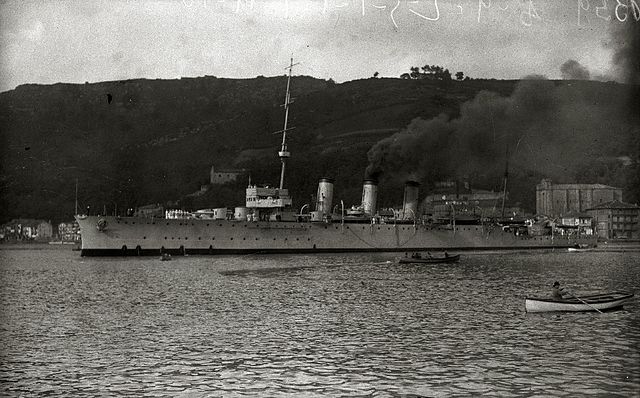
Blas de Lezo off the African coast
Both Méndez Núñez (after Casto Méndez Núñez, an admiral of the 19th Century) and Blas de Lezo (After Blas de Lezo y Olavarrieta, Spanish admiral of the 1700s) were laid down in SECN Ferrol yards, in April and September 1917. This is why most authors call this class after Blas de Lezo, but not Conway’s as the Méndez Núñez was completed before. Immediately, construction almost stopped as all equipments and parts deliveries from the British sub-contactors of the Vickers Armstrong yards has been iced. Materials started to arrive again towards the end of the war in small quantities, but construction really restarted well after WW1, in 1921. This allowed the ships to be launched in July 1922 and March 1923 and eventually completed two years after, in 1924 for the Nunez (exact date unknown) and March 1925 for the second.
Construction of the Blas de Lezo class
Although they looked close, the Blas de Lezo were distinct from the Reina Eugenia on multiple accounts:
The Spanish admiralty decided for a smaller, cheaper variant of the former, in order to decline it in two ships.
The class displaced less, at 6,312 tonnes fully loaded, for 140,2 m long, 14,02 m in width, and 7,00 m high versus 6,500 t fully loaded, 140,8 m long, 15,2 m wide and 5,6 m in draught.
For the propulsion, the Reina Victoria Eugenia differed from the British model, by having a twin-shaft machinery and a weakened protection. Armament of the Reina Vitoria was even weaker with only two twin banks of torpedo tubes. So for a lighter package, the Blas de Lezo class were better armed.
Propulsion-wise, the Vitoria Eugenia developed 25,000 ihp for 26 knots, while the Blas de Lezo machinery was brand new, and developed 23,000 hp, allowing to reach 27 knots. However this mixed propulsion prevented the ship from reaching a more adequate speed for the 1930s standards, which were above 29 knots for a light cruiser.
Armament:
It was entirely British, composed of six Vickers 152/50 mm (6-in), four 47/50 mm (2-in), four machine guns, and four triple 533 mm torpedo tubes banks (4×3) or 21-in. The ships were also provided with a 76 mm (3 in) field gun. Due to this British origin, provision delays meant the ships were unarmed for years.
In addition, they had no fire direction which rendered their fire inaccurate also in the 1930s. That’s one of the reasons that explains the Méndez Núñez was completely rebuilt as an A cruiser after the war.
Protection:
It was light, comprising an armored belt ranging from de 50 mm on both ends to 75 mm in the center. There was also an armored deck 25 mm thick. Gun shields were lightly protected.
Propulsion:
It consisted in 12 mixed Yarrow boilers, 6 burning coal and 6 burning oil. This was a substantial advantage for supplies. It also freed internal storage space, allowing to carry more fuel in tanks and giving extra range. The boilers were connected to two Parsons turbines, also supplied by the UK, connected to two locally forged screws.
The Blas de Lezo in action
On February 21, 1925, the brand new Spanish Armada cruiser started her official trials off Ferrol. Once she was fully commissioned, she was to start her service in fleet exercizes but was quickly deployed to cover the Alhucemas landings of 1925 in Morocco (Rif war).
In 1927, she was sent to China, trying to protect Spanish and European citizens during the bloody events caused by the power struggle between Wang Jingwei and Chiang Kai-Shek after the sudden death of President Sun Yat-sen. She later joined an international squadron anchored in the Yangtze River, off Shanghai. She returned in home waters in November of the same year while made a stop over in Manila.
During a naval manoeuver in 1932, near the cape Finisterre, between the coast and the shoal of O’Centolo, she hit one of two unmarked reefs at that time, splitting her keel. The unfortunate cruiser sank five miles offshore, at 76 meters deep (246 feets). Fortunately, the ship filled and sank slowly enough that there were no casualties.
However back home, a war council was held in 1933 to examine facts and establish responsibilities. However no charge was retained against the captain, since the ageing maps distributed to the Navy were at fault. Therefore the Blas de Lezo (which is still located near the reef) saw limited service, from 1925 to 1933, only seven years.
The double life of Méndez Núñez
Double, even triple life, since the ship was ordered under a parliamentary monarchy, knew Miguel Primo de Rivera’s dictatorship (1923–1930), and saw the Republic instituted (1931), but also the civil war (1936-39) and Franco’s regime during WW2, and the cold war until 1969. The ‘double life’ was in relation to her rebuilding in 1944-47.
When commissioned in 1924, the new cruiser participated in some exercise and for er first action, covered the landings of Alhucemas. At the occasion of the historic flight of a Dornier Wal Plus Ultra to Buenos Aires, the Spanish government sent the cruiser to a goodwill visit to Buenos Aires, accompanied by the destroyer Alsedo. These squadron arrived at La Plata on February 7, 1926. The rest of her career back home was marked by summer exercises and is rather obscure or without notable incident.
Civil War
When the civil war broke out however, in July 1936, Méndez Núñez was in Spanish Guinea (Equatorial Guinea). The crew decided to seize the ship without bloodshed following the coup d’etat of July 18, 1936. Transferring the ship to the Republicans was therefore a civilized and quiet affair, contrasting with the turmoil and in-fighting in other cases.
However the cruiser was not ready for this war. She was clearly outdated, with worn out machinery and insufficient speed, as she barely can make 26kts. She laso had a short-range artillery with an effective firing range below 12,000 m because of old optics of a pre-WW1 technology and no centralized control system.
She fought on the Republican side with hull camouflaged by using the silhouette of a destroyer to confuse observers at a distance, complete with a bow wave, giving also the impression that she was escorted and with a false speed. Crews used to joke about it, calling the ship “Méndez” and its painted fake destroyer “Núñez”.
Personal Note: Unfortunately i can’t find any photo of this painting, if you find one, please share it !
On March 6, 1938, under command of corvette captain Pedro Prado Mendizábal, she participated in the Battle of Cabo de Palos.
She was part of a small squadron of 2 light cruisers (with ) and 5 destroyer under Admiral Luis González de Ubieta’s command. After the ships met by chance at the dead of the night, the Republican admiral decided to chase the Nationalist cruiser Baleares, and the duel started at 02:15, both Nationalist cruisers concentrating first on Libertad from a range of about 5,000 m (5,500 yd). Unfortunately for them a star shell was fired which illuminated the Nationalists vessels and soon destroyers where on them, and sank the Baleares. Canarias stayed to continue duelling while covering the convoy to north africa but the battle was soon over. Eventually Méndez Núñez made few other sorties, without incident, and the war drew to its end.
On March 5, 1939, she left Cartagena to the point of falling along with the bulk of the Republican squadron for Bizerta (in Tunisia), arriving on March 11. The next day, political asylum was requested by the crew, was granted but they became confined, under the custody of a few Spanish crew members per ship. The rest of the crews were taken to a concentration camp in the town of Meheri Zabbens.
On March 31, 1939, new loyalist personnel taking care of the interned ships arrived in Bizerte. They went on the steamships Mallorca and Marqués de Comillas. She was back in Spain and still active when WW2 broke out.
WW2 and rebuilding

Franco’s Navy was in poor state, and in no shape to do any action. Certainly not to defy the Royal Navy off Gibraltar, as the idea was evocated by Hitler. Under standards of world war 2, it was clear that the Méndez Núñez design was totally outdated. There were only two options available in 1943, scrapping her or modernizing her as an anti-aircraft cruiser.
The latter was decided, not in the unlikely case Franco would join the axis but more to defend its neutrality and some territories safe, for example the tempting Balearic Islands. Plans were submitted to the admiralty for a complete rebuilding of the ship, which took place with some difficulties, finding spare parts, armaments, and a skilled workforce, between 1943 and 1947. At that date, however she was the most modern Spanish Cruiser in service.
As rebuilt, Nunez was given eight brand new long range 120 mm Vickers-Armstrong guns type F, 45 caliber (5 in), able to fire on aircraft as well as ships (dual purpose). They were placed in superfiring positions forward and aft, plus two abaft the rear superstructure. The configuration was inspired by WW2 AA cruisers, the Dido and Atlanta classes. This was completed by five twin 37 mm guns (presumably German models) of which two were placed in between funnels either side, and two just in front of the aft superstructure.
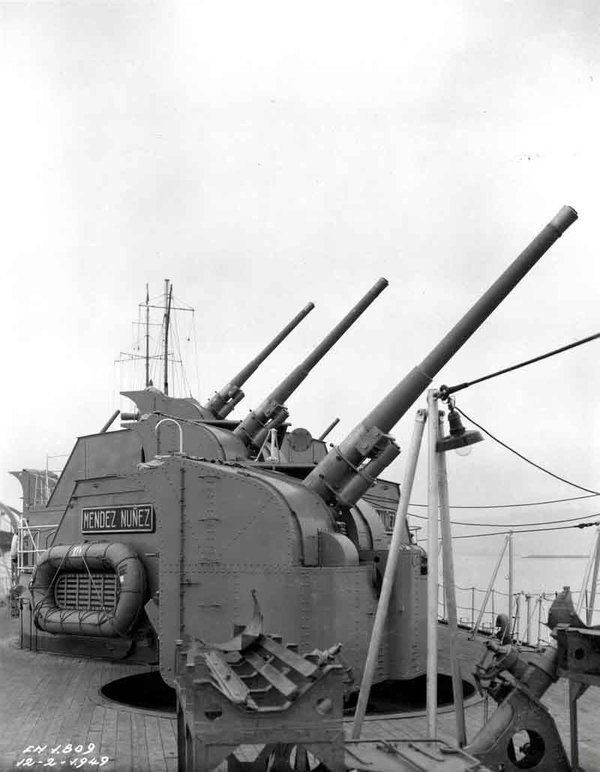
Details of the new 120 mm/44 Vickers F-type guns
In addition eight single 20 mm guns Flak 38 were placed in various positions at the rear of the ship. However the Spanish sources speaks of four quadruple FLAKvierling, which is consistent as well. A dedicated fire direction system was installed, with a modern Hazemeyer rangefinder forward over the main bridge and one aft, each directing their own guns;
In addition two triple standard 21-in torpedo tubes were maintained abaft the two funnels on the deck. For ASW warfare according to Spanish sources, the ship was also given 2 AsUW mortars, and one deep charges rack.
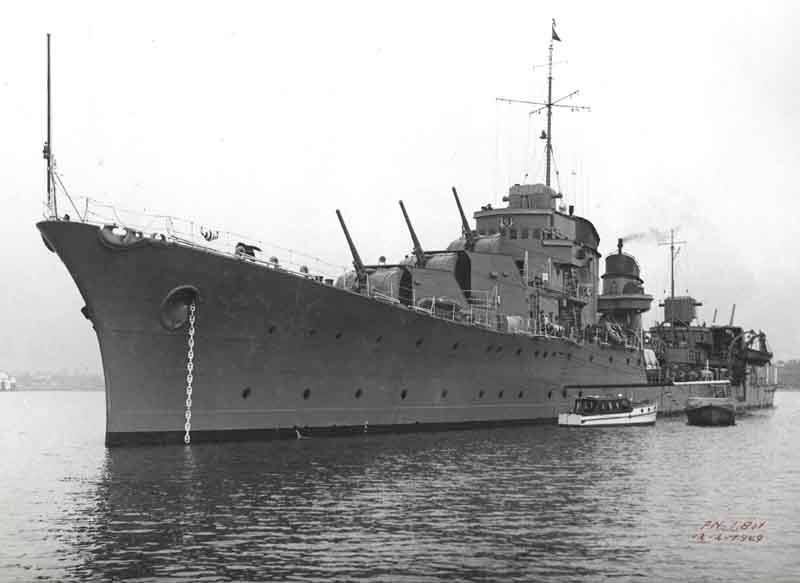
Needless to say the superstructure was totally rebuilt. The hull was rebuilt as well with many new arrangements for the ammunition wells, storage, crew quarters and two decks below, for the engines rooms. The prow was completely rebuilt as well with a new exagerated clipper shape, upper and longer of 7 feets (2,10 m).
The boilers were rearranged, but the boilers models stayed the same, although with truncated exhausts into two funnels instead of three. A new rig was fitted and her displacement rose to 4680 tonnes and 6045 fully loaded, but speed seemed to stay the same, as the powerplant did not varied and still partly burning coal. Also the ship carried no radar in 1947, but at least a Decca model was installed in 1950.
In her new cold war career there were few notable incidents. In 1947 she was near a magazine which detonated at Cadiz, and despite a rumor the ship was damaged or even sank, it was denied. On December 7, 1957, she participated in a fleet also composed of the cruiser Canarias, and five destroyers (Churruca, Admiral Miranda, Escaño, Gravina and José Luis Díez) making a battle training in front of Agadir, firing on prepared spots. She was eventually discarded in 1963.
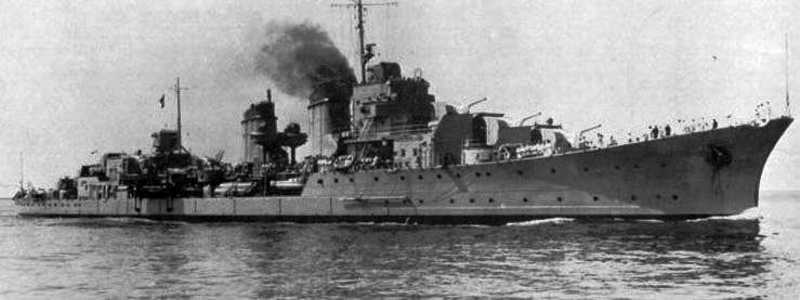
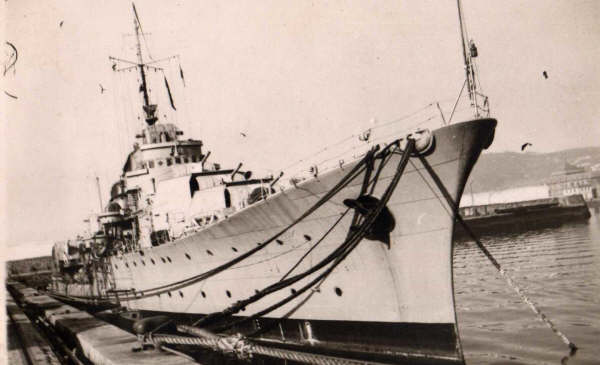
Méndez Núñez as rebuilt in 1947
Mendez Nunez (1925) |
|
| Dimensions | 140.2 x 14.02 x 4.7m (462 ft x 46 ft x 14 ft 4 in) |
| Displacement | 4,780 long tons (4,860 t) standard and 6,230 fully loaded |
| Crew | 320 |
| Propulsion | 4 shafts turbines, 12 Yarrow coal/oil-fired boilers |
| Speed | 29 knots (54 kph) |
| Range | 5,000 nmi (9,300 km) at 13 kn (24 km/h) |
| Armament | 6 × 6-in guns (152 mm) in single mounts, 4 × 47mm, 12 × 21-inch (533 mm) (triple banks). |
| Protection | Belt 2-3 in belt (50-75 mm), 1 in deck (25 mm), 6 in conning tower walls (152 mm) |
Read More/Src
Conway’s all the worlds fighting ships 1922-1946
Whitley MJ. Cruisers of World War 2 an International Encyclopedia
https://es.wikipedia.org/wiki/M%C3%A9ndez_N%C3%BA%C3%B1ez_(1924)
https://es.wikipedia.org/wiki/Blas_de_Lezo_(1924)
https://www.world-war.co.uk/spain/mendez.php3
http://www.revistanaval.com/www-alojados/armada/buques1/Mendez.htm
Models Corner:
Unfortunately it seems no model kit of these ships in 1925 or 1947 state has been proposed.
There is one somptuous scratchbuilt model however: http://www.modelwarships.com/reviews/ships/sn/Mendez-Nunez-350-fr/pages/31.htm
There has been a metal model made by Germany company Hansa >
There is also a 1/2400 scale on shapeways >


 Latest Facebook Entry -
Latest Facebook Entry -  X(Tweeter) Naval Encyclopedia's deck archive
X(Tweeter) Naval Encyclopedia's deck archive Instagram (@navalencyc)
Instagram (@navalencyc)





 French Navy
French Navy Royal Navy
Royal Navy Russian Navy
Russian Navy Armada Espanola
Armada Espanola Austrian Navy
Austrian Navy K.u.K. Kriegsmarine
K.u.K. Kriegsmarine Dansk Marine
Dansk Marine Nautiko Hellenon
Nautiko Hellenon Koninklije Marine 1870
Koninklije Marine 1870 Marinha do Brasil
Marinha do Brasil Osmanlı Donanması
Osmanlı Donanması Marina Do Peru
Marina Do Peru Marinha do Portugal
Marinha do Portugal Regia Marina 1870
Regia Marina 1870 Nihhon Kaigun 1870
Nihhon Kaigun 1870 Preußische Marine 1870
Preußische Marine 1870 Russkiy Flot 1870
Russkiy Flot 1870 Svenska marinen
Svenska marinen Søværnet
Søværnet Union Navy
Union Navy Confederate Navy
Confederate Navy Armada de Argentina
Armada de Argentina Imperial Chinese Navy
Imperial Chinese Navy Marinha do Portugal
Marinha do Portugal Mexico
Mexico Kaiserliche Marine
Kaiserliche Marine 1898 US Navy
1898 US Navy Sovietskiy Flot
Sovietskiy Flot Royal Canadian Navy
Royal Canadian Navy Royal Australian Navy
Royal Australian Navy RNZN Fleet
RNZN Fleet Chinese Navy 1937
Chinese Navy 1937 Kriegsmarine
Kriegsmarine Chilean Navy
Chilean Navy Danish Navy
Danish Navy Finnish Navy
Finnish Navy Hellenic Navy
Hellenic Navy Polish Navy
Polish Navy Romanian Navy
Romanian Navy Turkish Navy
Turkish Navy Royal Yugoslav Navy
Royal Yugoslav Navy Royal Thai Navy
Royal Thai Navy Minor Navies
Minor Navies Albania
Albania Austria
Austria Belgium
Belgium Columbia
Columbia Costa Rica
Costa Rica Cuba
Cuba Czechoslovakia
Czechoslovakia Dominican Republic
Dominican Republic Haiti
Haiti Hungary
Hungary Honduras
Honduras Estonia
Estonia Iceland
Iceland Eire
Eire Equador
Equador Iran
Iran Iraq
Iraq Latvia
Latvia Liberia
Liberia Lithuania
Lithuania Mandchukuo
Mandchukuo Morocco
Morocco Nicaragua
Nicaragua Persia
Persia San Salvador
San Salvador Sarawak
Sarawak Uruguay
Uruguay Venezuela
Venezuela Zanzibar
Zanzibar Warsaw Pact Navies
Warsaw Pact Navies Bulgaria
Bulgaria Hungary
Hungary

 Bundesmarine
Bundesmarine Dutch Navy
Dutch Navy Hellenic Navy
Hellenic Navy Marina Militare
Marina Militare Yugoslav Navy
Yugoslav Navy Chinese Navy
Chinese Navy Indian Navy
Indian Navy Indonesian Navy
Indonesian Navy JMSDF
JMSDF North Korean Navy
North Korean Navy Pakistani Navy
Pakistani Navy Philippines Navy
Philippines Navy ROKN
ROKN Rep. of Singapore Navy
Rep. of Singapore Navy Taiwanese Navy
Taiwanese Navy IDF Navy
IDF Navy Saudi Navy
Saudi Navy Royal New Zealand Navy
Royal New Zealand Navy Egyptian Navy
Egyptian Navy South African Navy
South African Navy






























 Ukrainian Navy
Ukrainian Navy dbodesign
dbodesign